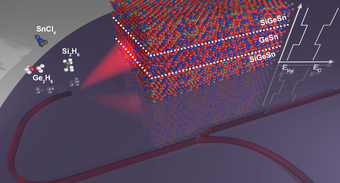SiGeSn ternaries for efficient group IV heterostructure light emitters
Jülich, 7. February 2017
The inability of the Group IV elements silicon (Si) and germanium (Ge), which form the backbone of today's electronic circuits, to efficiently generate light is hindering the integration of optoelectronics on a large scale.
The addition of the heavier group IV element tin (Sn) to the mix has helped overcome this obstacle, as optically pumped laser light has been observed at about 2.2 µm in Si-congruent GeSn alloys (Wirths and Geiger et al., Nature Photonics 2015). Efficient electrically driven light emitters such as LEDs and lasers additionally require materials with larger bandgaps to confine the injected charge carriers in the active region and enable their efficient radiative recombination.
Researchers at Forschungszentrum Jülich (Germany), in collaboration with international partners from the Paul Scherrer Institute (Switzerland), the University of Leeds (United Kingdom), and CEA-Leti (France), have studied the ternary group IV alloy SiGeSn for this purpose. By independently adjusting the Si and Sn content, they were able to tune the bandgap of the material in the shortwave infrared spectrum down to about 2.6 µm. The wide range of possible alloys could enable a wide variety of applications. In addition to their use as passive layers, they could also provide alternative active layers for mid-infrared detector applications or enable exclusively ternary light emitters.
To really prove that SiGeSn is a promising material, the researchers used it as a barrier material in a GeSn/SiGeSn multiquantum well heterostructure. Fully CMOS-compatible processing of LEDs resulted in strong, electrically driven light emission at room temperature, underpinning its use in future efficient group IV optoelectronics.

Article: Nils von den Driesch et al: SiGeSn Ternaries for Efficient Group IV Heterostructure Light Emitters
Article: Daniela Stange et al.: Short-wave infrared LEDs from GeSn/SiGeSn multiple quantum wells
